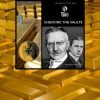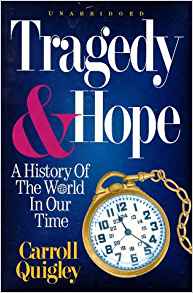Joseph Plummer’s Tragedy and Hope 101: The Illusion of Justice, Freedom, and Democracy is an eye-opening summary of one of the most powerful books ever written—Tragedy and Hope by historian Carroll Quigley. Plummer distills Quigley’s 1,300-page epic into a manageable read, focusing on the core concepts that reveal the disturbing truth behind the illusion of democratic governance. Through Quigley’s insider knowledge, we learn that our systems of justice, freedom, and democracy are cleverly constructed facades, maintained by a small group of powerful elites.
In this article, we will explore some of the most unsettling examples from Plummer’s work, shedding light on the mechanisms of control that operate behind the scenes of what we mistakenly call democracy. By the end of this journey, you’ll understand how the world truly works and why the fight for real justice and freedom is far from over.
Democracy: An Elaborate Charade
Plummer opens with a stark assertion: the democracy we live in is nothing more than a show. Most people believe their vote matters, that they have a say in shaping their government. However, Plummer, drawing on Quigley’s research, explains that the ruling elites have no fear of democratic elections. These powerful individuals control both sides of the political spectrum, ensuring that no matter who is elected, the same agenda is followed.
One of the most striking examples in the book is Quigley’s revelation that political parties are deliberately designed to be nearly identical in their policies. According to Plummer, Quigley admitted that the elites intentionally make the two major political parties so similar that voters can throw one out without causing significant change. This gives the public the illusion of choice, while the real decisions are made behind closed doors by unelected figures.
In today’s world, we see this at play when mainstream candidates from opposing parties promote nearly identical policies on major issues, leaving the people disillusioned and powerless to enact real change.
The Real Power Lies Behind the Throne
While presidents, prime ministers, and elected officials are paraded as the faces of power, the reality is much darker. Plummer emphasizes that these figures are little more than puppets controlled by powerful, hidden networks. Quigley referred to this as “the network”—a group of wealthy individuals and organizations that work behind the scenes to influence global policy and control governments.
One of the book’s most shocking revelations comes from Quigley’s experience with this network. Plummer recounts how Quigley, despite being sympathetic to their goals, was eventually silenced after publishing Tragedy and Hope. The book, which provided a rare glimpse into the workings of this network, was quickly pulled from the market, and Quigley’s publishing rights were tampered with to suppress further exposure. This example serves as a reminder that even someone as connected as Quigley could not escape the network’s reach once he revealed too much.
Today, the influence of this hidden power is evident in global organizations like the Council on Foreign Relations (CFR) and the World Economic Forum, where unelected elites gather to discuss policies that will shape the future of nations.
The Economic Trap: Control Through Debt
Plummer, following Quigley’s research, explains how the financial system is the cornerstone of elite control. At the heart of this system is debt. By keeping nations and individuals in perpetual debt, the elites ensure that everyone remains enslaved to the system. The illusion of freedom is maintained through consumer culture and the ability to “choose” how to spend, but in reality, most people work simply to service their debts.
An astonishing example from the book is how central banks, which are controlled by private interests, have been able to manipulate entire economies through monetary policy. Plummer points out that this system was designed to consolidate wealth in the hands of a few while ensuring that the majority remains dependent on credit to survive.
Today’s global financial crises, from the 2008 crash to rising national debts, demonstrate how deeply embedded this system is. Even when governments attempt to address these issues, they find themselves restricted by the very financial structures that keep them in power.
Perception Management: Controlling the Masses Through Media
In Tragedy and Hope 101, Plummer also dives into the role of the media in shaping public perception. Quigley had revealed that major media outlets were long ago co-opted by the elite network to serve as tools of manipulation rather than sources of information. By controlling what people see, hear, and read, these elites can steer public opinion in whichever direction they choose.
Plummer provides several jaw-dropping examples of how this works. One of the most infamous is the control exerted over academic institutions and the press during the 20th century, which resulted in the suppression of any dissenting voices that might challenge the status quo. The same forces continue to operate today, where mass media often ignores or distorts stories that would expose the system’s inner workings.
From the Iraq War to the financial collapse, we can see how the media narrative is carefully curated to prevent the masses from understanding the true motivations behind world events.
The Path Forward: Awareness and Resistance
Plummer’s work, while grim, is not without hope. He insists that awareness is the first step toward change. Once we see through the illusion, we can begin to resist the control exerted by these elites. It starts with understanding the depth of manipulation, which Tragedy and Hope 101 makes accessible.
Plummer encourages readers to question the narratives they have been taught, challenge the systems that perpetuate inequality, and seek out alternative sources of information that are not influenced by the hidden power structures. The battle for justice, freedom, and true democracy is long, but it is a battle that can be won if enough people wake up to the reality of their situation.
Wake Up and Take Action
Joseph Plummer’s Tragedy and Hope 101 is a must-read for anyone who wants to understand the real power dynamics that shape our world. It provides a digestible yet powerful summary of Carroll Quigley’s monumental work, exposing the control systems that keep us all in check.
This book is not just a critique of the past; it is a warning for the present and future. As more people fall into the traps of debt, misinformation, and political charades, the need for awareness grows ever more urgent.
If you’re ready to open your eyes and see the world as it truly is, I encourage you to get a copy of Tragedy and Hope 101 on Amazon. This book will change the way you see the world forever.





